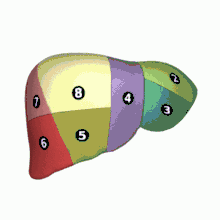Liver segment
A liver segment is one of eight segments of the liver as described in the widely used Couinaud classification (named after Claude Couinaud) in the anatomy of the liver. This system divides the lobes of the liver into eight segments based on a transverse plane through the bifurcation of the main portal vein.[1]
| Liver segment | |
|---|---|
 Couinaud classification system | |
| Details | |
| Part of | Liver |
| Anatomical terminology | |
Segments

The fissure for the round ligament of the liver (ligamentum teres) also separates the medial and lateral segments. The medial segment is also called the quadrate lobe. In the widely used Couinaud classification, the lobes of the liver are further divided into eight segments based on a transverse plane through the bifurcation of the main portal vein.[1] The caudate lobe is a separate structure which receives blood flow from both the right- and left-sided vascular branches.[2][3] The Couinaud classification of liver anatomy divides the liver into eight functionally independent segments. Each segment has its own vascular inflow, outflow and biliary drainage. In the centre of each segment there is a branch of the portal vein, hepatic artery and bile duct. In the periphery of each segment there is vascular outflow through the hepatic veins.[4] The division of the liver into independent units means that segments can be resected without damaging the remaining segments.[5] To preserve the viability of the liver following surgery, resections follow the vessels defining the peripheries of each segment. This means that resection lines parallel the hepatic veins, leaving the portal veins, bile ducts, and hepatic arteries intact.[1]
The classification system uses the vascular supply in the liver to separate the functional segments (numbered I to VIII):
- Segment I is the caudate lobe and is situated posterior l and it may receive its supply from both the right and the left branches of portal vein. It contains one or more hepatic veins which drain directly into the IVC.[1]
The remainder of the segments (II to VIII) are numbered in a clockwise fashion:[4]
- Segments II and III lie lateral to the falciform ligament with II superior to the portal venous supply and III inferior
- Segment IV lies medial to the falciform ligament and is subdivided into IVa (superior) and IVb (inferior)
Segments V to VIII make up the right part of the liver:[4]
- Segment V is the most medial and inferior
- Segment VI is located more posteriorly
- Segment VII is located above segment VI
- Segment VIII sits above segment V in the superio-medial position
References
- "Couinaud classification | Radiology Reference Article". Radiopaedia.org. Retrieved 2015-06-26.
- "Three-dimensional Anatomy of the Couinaud Liver Segments". Retrieved 2009-02-17.
- Strunk, H.; Stuckmann, G.; Textor, J.; Willinek, W. (2003). "Limitations and pitfalls of Couinaud's segmentation of the liver in transaxial Imaging". European Radiology. 13 (11): 2472–82. doi:10.1007/s00330-003-1885-9. PMID 12728331.
- "The Radiology Assistant : Anatomy of the liver segments". Radiologyassistant.nl. 2006-05-07. Retrieved 2015-06-26.
- "Hepatic segments (Couinaud classification) / Radiological classifications commonly used on medical imaging / Radiology / Channels / e-Cases /". IMAIOS.com. Retrieved 2015-06-26.
External links
- Radiopaedia overview